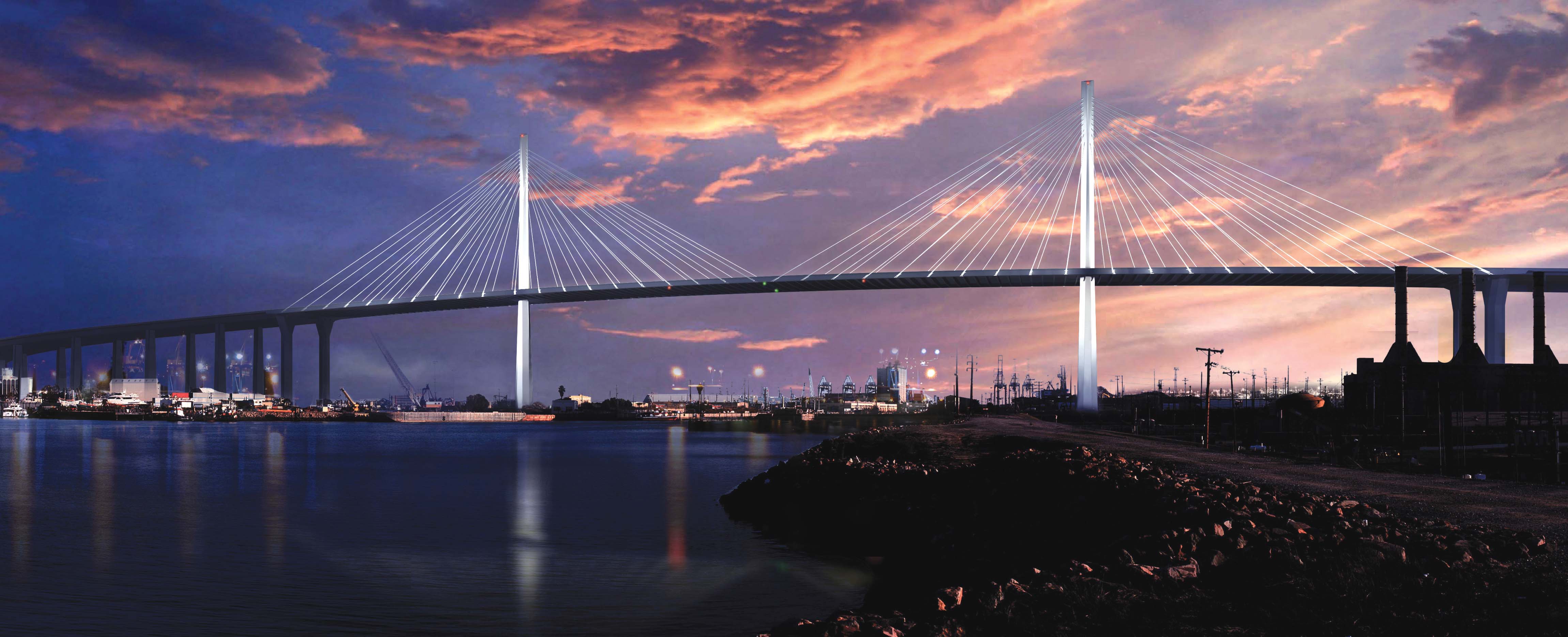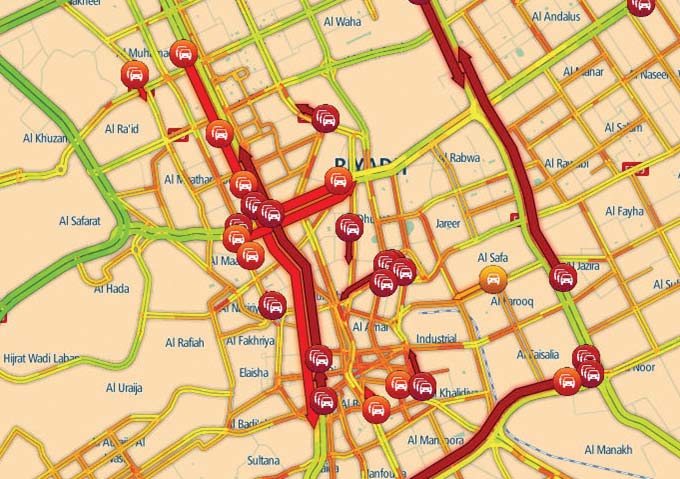David Crawford previews a work zone travel breakthrough. In February 2014, the Port of Long Beach in California launched what it claims is a groundbreaking construction zone navigation aid - LB Bridge mobile app. The app is designed to help drivers during the Gerald Desmond Bridge replacement programme by keeping them up to date on activity and the ensuing traffic diversions when construction starts in summer 2014. The unusually content-rich app is designed to convey current project news (enlivened by phot

Artist's impression of the new Gerald Desmond Bridge (image Port of Long Beach)
David Crawford previews a work zone travel breakthrough.
In February 2014, the Port of Long Beach in California launched what it claims is a groundbreaking construction zone navigation aid - LB Bridge mobile app. The app is designed to help drivers during the Gerald Desmond Bridge replacement programme by keeping them up to date on activity and the ensuing traffic diversions when construction starts in summer 2014.
The unusually content-rich app is designed to convey current project news (enlivened by photos and video streaming) and recommended detours. It carries hands-free audio traffic alerts in English and Spanish as well as extended webcam coverage of traffic conditions on both highways and local streets. Port community relations manager John Pope told ITS International: “It’s important to show both, because our app users will use both.
“Road status is becoming more and more critical to the average motorist in Southern California. Los Angeles radio and TV traffic reporters are looking to online, web and app updates for the latest news to share with their audiences. We also know the importance of having streets and highways properly labelled.
“We aim to remove a lot of guesswork. Our app will give specific advice on lane closures and show alternative routes in a single package.”
The US$1.2bn replacement scheme, on which ground clearance started in August 2013, will replace the existing two lanes in each direction crossing with one, each with three lanes in either direction. In the process it will deliver one of the tallest cable-stayed bridges in the US and the first of its kind in California.
It will link the Californian mainland across the Back Channel (which leads into the Port’s inner harbour) with the 11.56km2 Terminal Island, a largely artificially created complex of container and bulk terminals which extend the Port area. Together with the neighbouring port of Los Angeles, the area makes up the largest harbour complex in the US, handling a quarter of all its container cargo traffic.
Said Pope: “We included live webcam coverage to encourage users to check out current traffic conditions before heading out onto the road.” The port is also installing additional webcams, and their widened coverage will show up on both the app and the Bridge website.
The app is available for iPhone, iPad, Android and Windows Phone users, who will receive breaking alerts on up-to-the-minute conditions when they are near or at the bridge site. It incorporates Google mapping which works in sync with changes in traffic management and has already been in use to alert motorists to a traffic accident on the existing bridge. Because the bridge site is close to other current traffic improvement schemes, the Port has decided to extend the app’s coverage to include traffic updates for these as well, to help port tenants and the driving public. These updates also go out via email.
The app has emerged as a communications-driven initiative in a joint venture between the Port, its public information consultant – Westbound Communications, which first proposed the concept – and app developer Penn Digital. Penn Digital had previously provided Westbound with an emergency preparedness mobile app for the neighboring Orange County government.
Said Pope: “It’s not yet very common for US government agencies, at least in California, to make use of apps in their public outreach. I’m not aware of any other apps being devoted specifically to major infrastructure projects in our part of the US.”
Westbound’s president, Scott Smith, added: “The original idea came out of a brainstorming session in mid-2012, when we were working on our public information proposal and realised that our target audiences would need to be kept informed while on the go. At that time, we thought there were probably other apps available.
“But then we checked and found that we were breaking new ground. When we presented the concept, John Pope and his team loved it and asked us to build it out. Working with Erik Penn of Penn Digital, we then added innovative elements such as the video streaming and audio traffic updates.
“We believe the app will play a significant role in our communications efforts for one of the most important infrastructure projects in the Western US. Having this kind of technology available greatly assists our job in explaining the benefits, alerting motorists to upcoming traffic impacts, and getting the area excited about its new icon.”
Erik Penn from Penn Digital said: “Loading page content happens in real time. We have achieved this by setting up a PHP hypertext preprocessor to interact with the native software development kit for Apple’s iOS, Android and Windows, making the app easier to maintain.
The existing (1968) Gerald Desmond Bridge is one of four crossings to Terminal Island and a key business corridor serving 15% of all the US’ imported waterborne cargo. It carries some 68,000 vehicles a day, two-thirds of them by passenger cars carrying port workers and commuters, the rest by trucks. The proportion of truck traffic is expected to grow following planned improvements at both ports.
When complete the new bridge will be 610m long with a 305m main span and two 150m-tall mast towers that will increase the clearance over the Back Channel to 60m, allowing the world’s largest ships to enter the Port’s inner harbour. The current crumbling structure will be demolished once the replacement is completed and in the meantime undersling netting protects ships and workers beneath from falling masonry.
“The effort to create each additional version reduced once the iOS version was approved as the archetype.” The app incorporates API integration with YouTube and Flickr, as well as with Google Maps. An integral content management system allows written input, images and video content to change without the need for additional programming.
Content generation starts with a working group of Port traffic and construction engineers and support staff, bridge project engineers, security managers and Westbound personnel. The group consider road conditions and discuss planned closures and detours which are logged in an internal database.
Westbound staff compile the database information to create most, if not all, of the content on the app.This links back to the website so the website content is updated, all changes appear on the app. Penn Digital provides maintenance. As the new bridge is its location atop the Wilmington oilfield - the third largest in the contiguous US – there has been months of activity to prepare the ground for piling. The app will convey information on the traffic impacts of remaining clearance work.
By 22 April 2014 - well before construction was due to start – the app had been downloaded more than 1,130 times. “Our original goal was to have 500 in the first six months,” said Pope. “These have been occurring all over the world – in Japan, Australia and even Antarctica. So we assume that bridge engineers and enthusiasts in other countries want to monitor our progress.”
He anticipates possible future upgrades as conditions warrant, but said: “We’re pretty happy with the robust technology and features we have already. When construction begins, the app will get properly road-tested - so we look forward to hearing from our subscribers and will potentially be able to make further changes based on their comments.
“So far, the anecdotal feedback has been very positive. Meanwhile, some of our counterparts in the California Department of Transportation have been showing interest in the idea; although we don’t anticipate broader attention in North America until construction begins.”
The intellectual property in the app is co-owned by the Port of Long Beach and Penn Digital. Plans for its continuing use following completion of the bridge, for instance as part of the traffic management system, have yet to be decided.
In February 2014, the Port of Long Beach in California launched what it claims is a groundbreaking construction zone navigation aid - LB Bridge mobile app. The app is designed to help drivers during the Gerald Desmond Bridge replacement programme by keeping them up to date on activity and the ensuing traffic diversions when construction starts in summer 2014.
The unusually content-rich app is designed to convey current project news (enlivened by photos and video streaming) and recommended detours. It carries hands-free audio traffic alerts in English and Spanish as well as extended webcam coverage of traffic conditions on both highways and local streets. Port community relations manager John Pope told ITS International: “It’s important to show both, because our app users will use both.
“Road status is becoming more and more critical to the average motorist in Southern California. Los Angeles radio and TV traffic reporters are looking to online, web and app updates for the latest news to share with their audiences. We also know the importance of having streets and highways properly labelled.
“We aim to remove a lot of guesswork. Our app will give specific advice on lane closures and show alternative routes in a single package.”
The US$1.2bn replacement scheme, on which ground clearance started in August 2013, will replace the existing two lanes in each direction crossing with one, each with three lanes in either direction. In the process it will deliver one of the tallest cable-stayed bridges in the US and the first of its kind in California.
It will link the Californian mainland across the Back Channel (which leads into the Port’s inner harbour) with the 11.56km2 Terminal Island, a largely artificially created complex of container and bulk terminals which extend the Port area. Together with the neighbouring port of Los Angeles, the area makes up the largest harbour complex in the US, handling a quarter of all its container cargo traffic.
Said Pope: “We included live webcam coverage to encourage users to check out current traffic conditions before heading out onto the road.” The port is also installing additional webcams, and their widened coverage will show up on both the app and the Bridge website.
The app is available for iPhone, iPad, Android and Windows Phone users, who will receive breaking alerts on up-to-the-minute conditions when they are near or at the bridge site. It incorporates Google mapping which works in sync with changes in traffic management and has already been in use to alert motorists to a traffic accident on the existing bridge. Because the bridge site is close to other current traffic improvement schemes, the Port has decided to extend the app’s coverage to include traffic updates for these as well, to help port tenants and the driving public. These updates also go out via email.
The app has emerged as a communications-driven initiative in a joint venture between the Port, its public information consultant – Westbound Communications, which first proposed the concept – and app developer Penn Digital. Penn Digital had previously provided Westbound with an emergency preparedness mobile app for the neighboring Orange County government.
Said Pope: “It’s not yet very common for US government agencies, at least in California, to make use of apps in their public outreach. I’m not aware of any other apps being devoted specifically to major infrastructure projects in our part of the US.”
Westbound’s president, Scott Smith, added: “The original idea came out of a brainstorming session in mid-2012, when we were working on our public information proposal and realised that our target audiences would need to be kept informed while on the go. At that time, we thought there were probably other apps available.
“But then we checked and found that we were breaking new ground. When we presented the concept, John Pope and his team loved it and asked us to build it out. Working with Erik Penn of Penn Digital, we then added innovative elements such as the video streaming and audio traffic updates.
“We believe the app will play a significant role in our communications efforts for one of the most important infrastructure projects in the Western US. Having this kind of technology available greatly assists our job in explaining the benefits, alerting motorists to upcoming traffic impacts, and getting the area excited about its new icon.”
Erik Penn from Penn Digital said: “Loading page content happens in real time. We have achieved this by setting up a PHP hypertext preprocessor to interact with the native software development kit for Apple’s iOS, Android and Windows, making the app easier to maintain.
The existing (1968) Gerald Desmond Bridge is one of four crossings to Terminal Island and a key business corridor serving 15% of all the US’ imported waterborne cargo. It carries some 68,000 vehicles a day, two-thirds of them by passenger cars carrying port workers and commuters, the rest by trucks. The proportion of truck traffic is expected to grow following planned improvements at both ports.
When complete the new bridge will be 610m long with a 305m main span and two 150m-tall mast towers that will increase the clearance over the Back Channel to 60m, allowing the world’s largest ships to enter the Port’s inner harbour. The current crumbling structure will be demolished once the replacement is completed and in the meantime undersling netting protects ships and workers beneath from falling masonry.
“The effort to create each additional version reduced once the iOS version was approved as the archetype.” The app incorporates API integration with YouTube and Flickr, as well as with Google Maps. An integral content management system allows written input, images and video content to change without the need for additional programming.
Content generation starts with a working group of Port traffic and construction engineers and support staff, bridge project engineers, security managers and Westbound personnel. The group consider road conditions and discuss planned closures and detours which are logged in an internal database.
Westbound staff compile the database information to create most, if not all, of the content on the app.This links back to the website so the website content is updated, all changes appear on the app. Penn Digital provides maintenance. As the new bridge is its location atop the Wilmington oilfield - the third largest in the contiguous US – there has been months of activity to prepare the ground for piling. The app will convey information on the traffic impacts of remaining clearance work.
By 22 April 2014 - well before construction was due to start – the app had been downloaded more than 1,130 times. “Our original goal was to have 500 in the first six months,” said Pope. “These have been occurring all over the world – in Japan, Australia and even Antarctica. So we assume that bridge engineers and enthusiasts in other countries want to monitor our progress.”
He anticipates possible future upgrades as conditions warrant, but said: “We’re pretty happy with the robust technology and features we have already. When construction begins, the app will get properly road-tested - so we look forward to hearing from our subscribers and will potentially be able to make further changes based on their comments.
“So far, the anecdotal feedback has been very positive. Meanwhile, some of our counterparts in the California Department of Transportation have been showing interest in the idea; although we don’t anticipate broader attention in North America until construction begins.”
The intellectual property in the app is co-owned by the Port of Long Beach and Penn Digital. Plans for its continuing use following completion of the bridge, for instance as part of the traffic management system, have yet to be decided.










